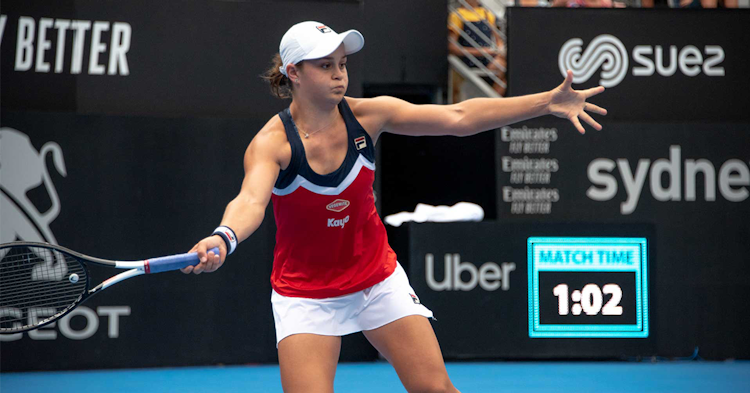Ash Barty: Unimpressively Impressive
Last updated: Oct 2, 2019, 6:57AM | Published: Oct 2, 2019, 6:56AM
This image is a derivative of Sydney International Tennis WTA Premier by Rob Keating (CC BY-SA 2.0)
Living a complicated life in a complicated world invites paradoxes, counterintuitive truths, and layered realities in which competing tensions coexist.
Ash Barty might not own the most complicated career in tennis, but she certainly is a walking, breathing manifestation of many tennis paradoxes at the moment.
The key insight into Barty’s 2019 season after her semi-final loss to Aryna Sabalenka at the Wuhan Open is as follows: These contradictions do contain worrisome elements, but should ultimately be seen (at least at the moment) as positive indicators for the WTA’s World No. 1 tennis player.
The Wuhan Open embodies the contradictions of Barty’s 2019 season, and when sorting out all of the contradictions, the end result should be an increased level of appreciation for what Australia’s modern tennis star is achieving.
The first and most obvious contradiction in Ash Barty’s current tennis journey – which was reaffirmed this past week in Wuhan – is that Barty is World No. 1 while not playing dominant tennis. The groove Barty gained in Miami and then regained for roughly six weeks (late May through early July) has not been rediscovered in the second half of the season on hardcourts, either in North America or China.
Being a target for the rest of the WTA Tour is part of the reason for this inability to play full-flight tennis. The opposition always has a say in the outcome on a tennis court.
The natural strain attached to the new reality of being a major champion – learning how to carry an elevated position with an easy confidence and an unmanufactured swagger – is also part of this process for Barty.
<ad>
Tennis since the beginning of August has not looked easy for Barty, the way it did for much of Roland Garros and during the grass season in June. Barty has experienced “the zone,” the period every athlete covets when shots are popping off the strings just right and everything is flowing in perfect harmony.
Zones, however, don’t generally last for long periods of time. Staying at the top of a sport is achieved by figuring out ways to win when the zone doesn’t emerge and an opponent asks difficult questions.
Sports are fun, but they are also hard work. Tennis players at the top of their sport make millions of dollars traveling around the world. There is a certain amount of glamour to the larger world of an elite athlete. Yet, the substance of competition is anything but glamorous: It is very hard work, sandwiched between a constant series of long-distance plane flights and unfamiliar hotel beds in strange places.
Barty is familiar with the routines of a tennis player, but still relatively new to the reality of being a player everyone wants to beat.
The Wuhan semi-finals represented a fascinating matchup because Barty’s opponent had profoundly failed in the first eight and a half months of 2019 to adjust to her own new reality as a tennis player.
Aryna Sabalenka did not rise to Barty’s height. The Belarusian hasn’t reached a major quarter-final yet. She hasn’t reached the top five yet, let alone World No. 1. Sabalenka has attained merely a fraction of what Barty has achieved.
Yet, because Sabalenka was so hugely successful in the second half of the 2018 season, she became a target for the rest of the tour at the start of 2019. She did not handle it well.
She and Barty do not occupy the same universe (or at least not the same continent) in terms of singles achievements, but the two women – who have stared down each other across the net in multiple doubles finals this year – do share the larger experience of adjusting to increased stature in the sport, and the added pressure which comes with it.
They know this process – stepping into a new mindset – is not easy.
<ad>
Interestingly, after many months of struggling, Sabalenka – who won Wuhan last year – has regained a measure of belief in China. If she played like a burdened athlete for most of 2019, she has tapped into a well of renewal in Wuhan.
She played with hunger, not with fear of success. She played with clarity instead of being indecisive.
Barty, who did not handle tight scoreboard situations well in her stinging U.S. Open fourth-round loss to Wang Qiang, was unable to solve the Sabalenka puzzle in Wuhan.
On the surface, this was yet another tournament in which Barty failed to play her best. She gets roped into up-and-down three-set matches early in a tournament, and instead of using a three-set escape as a portal to dominant tennis in the latter stages of a tournament (the way Serena Williams and other legendary players would regularly do in their primes), she loses to a more in-form player.
This Wuhan tournament could readily be compared to Cincinnati, another Premier 5 tour stop in which Barty survived long enough to make the semi-finals, but ran out of ideas against a plainly better player, but also someone who had not played nearly as much tennis during the season due to a lack of wins in the first half of 2019.
The overall product isn’t impressive in any obvious way. The week in Wuhan – like Cincinnati – did not dazzle or amaze.
Yet, in its unimpressiveness, this week in Wuhan was significantly impressive for Barty. Cincinnati can be viewed the same way.
When you look at the larger landscape of women’s tennis, you see a world in which being seeded highly means very little. The woman Sabalenka will play for the Wuhan title, Alison Riske, defeated three top-eight seeds to make the final as an unseeded player. Only two of the top eight seeds reached the semifinals: Barty and fifth-seeded Petra Kvitova.
Given the frequency with which high seeds at 2019 WTA tournaments lose in the early rounds, a semifinal loss – while not what a No. 1 seed would ideally hope for – still represents a solid result for Barty.
It is better than what most of her top-10 peers are achieving.
<ad>
It should dawn upon an outside observer that Barty, by accumulating these “unimpressively impressive” semi-finals in Wuhan and Cincinnati – struggling with her game but notching considerable clusters of ranking points in spite of those struggles – has solidified her World No. 1 status.
These are the precise tournaments which other top WTA players have comparatively lacked in 2019. These tournaments are important building blocks in establishing Barty’s place in the sport.
Unless World No. 2 Karolina Pliskova makes a big charge in Beijing or at the WTA Finals in Shenzhen, Barty is likely to become the year-end World No. 1 player on the WTA Tour, the main goal this next month of tennis is meant to attain.
Being unimpressively impressive is exactly why Barty has the inside track to an historic achievement in her career.
It seems unrealistic to expect Barty – in these next several weeks – to recapture the form she displayed in late March (Miami) or June (Europe). The strain of the season has been evident in her game for months. Yet, if she makes a few more semifinals at important tournaments despite not playing her best, it will take a mighty effort by Pliskova to take World No. 1 away from her.
Unimpressive tennis has rarely been so productive… or admirable.
RELATED: The Dilemma of Ash Barty vs Top 20 Opponents
Did you enjoy this article? Leave a comment below, or join the conversation on the Stats Insider Twitter or Facebook page.



